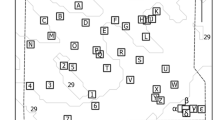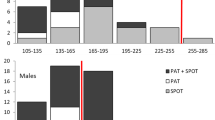Abstract
Populations of mobulid rays are declining globally through a combination of directed fisheries and indirect anthropogenic threats. Understanding the movement ecology of these rays remains an important priority for devising appropriate conservation measures throughout the world’s oceans. We sought to determine manta movements across several temporal and spatial scales with a focus on quantifying site fidelity and seasonality in the northern Farasan Banks, Red Sea. We fitted manta rays with acoustic transmitters (n = 9) and pop-up satellite archival transmitting (PSAT) tags (n = 9), including four with GPS capability (Fastloc), during spring 2011 and 2012. We deployed an extensive array of acoustic receivers (n = 67) to record movements of tagged mantas in the study area. All acoustically tagged individuals traveled frequently among high-use receiver locations and reefs and demonstrated fidelity to specific sites within the array. Estimated and realized satellite tag data indicated regional movements <200 km from the tagging location, largely coastal residency, and high surface occupation. GPS-tagged individuals regularly moved within the coastal reef matrix up to ~70 km to the south but continued to return to the tagging area near the high-occupancy sites identified in the acoustic array. We also tested the accuracy of several geolocation models to determine the best approach to analyze our light-based satellite tag data. We documented significant errors in light-based movement estimates that should be considered when interpreting tracks derived from light-level geolocation, especially for animals with restricted movements through a homogenous temperature field. Despite some error in satellite tag positions, combining results from PSAT and acoustic tags in this study yielded a comprehensive representation of manta spatial ecology across several scales, and such approaches will, in the future, inform the design of appropriate management strategies for manta rays in the Red Sea and tropical regions worldwide.






Similar content being viewed by others
References
Alava MNR, Dolumbaló ERZ, Yaptinchay AA, Trono RB (2002) Fishery and trade of whale sharks and manta rays in the Bohol Sea, Philippines. IUCN, Gland and Cambridge, pp 132–148
Antonius A, Bouchon C, Scheer G (1990) Corals of the eastern Red Sea. Smithsonian Institution Press, Washington, DC
Berumen ML, Hoey AS, Bass WH et al (2013) The status of coral reef ecology research in the Red Sea. Coral Reefs 32:737–748
Berumen ML, Braun CD, Cochran JEM et al (2014) Movement patterns of juvenile whale sharks tagged at an aggregation site in the red sea. PLoS One 9:e103536. doi:10.1371/journal.pone.0103536
Bigelow HB, Schroeder WC (1953) Sawfishes, guitarfishes, skates and rays. Sears Foundation for Marine Research, Yale University Press, New Haven, CT
Block BA, Dewar H, Blackwell SB et al (2001) Archival and pop-up satellite tagging of Atlantic bluefin tuna. Electronic tagging and tracking in marine fisheries. Springer, Berlin, pp 65–88
Bonfil R, Meyer M, Scholl MC et al (2005) Transoceanic migration, spatial dynamics, and population linkages of white sharks. Science 310:100–103. doi:10.1126/Science.1114898
Braun CD, Skomal GB, Thorrold SR, Berumen ML (2014) Diving behavior of the reef manta ray links coral reefs with adjacent deep pelagic habitats. PLoS One 9:e88170. doi:10.1371/journal.pone.0088170
Cagua FE, Berumen ML, Tyler EHM (2013) Topography and biological noise determine acoustic detectability on coral reefs. Coral Reefs 32:1123–1134
Cagua EF, Cochran JEM, Rohner CA et al (2015) Acoustic telemetry reveals cryptic residency of whale sharks. Bio Lett 11:20150092. doi:10.1098/rsbl.2015.0092
Carey FG, Scharold JV, Kalmijn AJ (1990) Movements of blue sharks (Prionace glauca) in depth and course. Mar Biol 106:329–342
Clark TB (2010) Abundance, home range, and movement patterns of manta rays (Manta alfredi, M. birostris) in Hawai’i. Dissertation, University of Hawai’i, Manoa, Hawai’i USA
Couturier LIE, Jaine FRA, Townsend KA et al (2011) Distribution, site affinity and regional movements of the manta ray, Manta alfredi (Krefft, 1868), along the east coast of Australia. Mar Freshw Res 62:628–637. doi:10.1071/Mf10148
Couturier LI, Marshall AD, Jaine FR et al (2012) Biology, ecology and conservation of the Mobulidae. J Fish Biol 80:1075–1119. doi:10.1111/j.1095-8649.2012.03264.x
Deakos MH (2010) Ecology and social behavior of a resident manta ray (Manta alfredi) population off Maui, Hawai’i. Dissertation, University of Hawai’i, Manoa, Hawai’i USA
Deakos MH (2012) The reproductive ecology of resident manta rays (Manta alfredi) off Maui, Hawaii, with an emphasis on body size. Environ Biol Fish 94:443–456. doi:10.1007/S10641-011-9953-5
Deakos MH, Baker JD, Bejder L (2011) Characteristics of a manta ray Manta alfredi population off Maui, Hawaii and implications for management. Mar Ecol Prog Ser 420:245–260
Dewar H (2002) Preliminary report: Manta harvest in Lamakera. Report from the Pfleger Institute of Environmental Research and the Nature Conservancy, pp 3
Dewar H, Mous P, Domeier M et al (2008) Movements and site fidelity of the giant manta ray, Manta birostris, in the Komodo Marine Park, Indonesia. Mar Biol 155:121–133. doi:10.1007/S00227-008-0988-X
Dujon AM, Lindstrom RT, Hays GC (2014) The accuracy of Fastloc-GPS locations and implications for animal tracking. Methods Ecol Evol. doi:10.1111/2041-210X.12286
Dulvy NK, Baum JK, Clarke S et al (2008) You can swim but you can’t hide: the global status and conservation of oceanic pelagic sharks and rays. Aquat Conserv Mar Freshw Ecosyst 18:459–482. doi:10.1002/aqc.975
Ekstrom PA (2004) An advance in geolocation by light. Mem Natl Inst Polar Res 58:210–226
Ferretti F, Worm B, Britten GL et al (2010) Patterns and ecosystem consequences of shark declines in the ocean. Ecol Lett 13:1055–1071
Galuardi B, Royer F, Golet W et al (2010) Complex migration routes of Atlantic bluefin tuna (Thunnus thynnus) question current population structure paradigm. Can J Fish Aquat Sci 67:966–976. doi:10.1139/F10-033
Gladstone W (2000) The ecological and social basis for management of a Red Sea marine-protected area. Ocean Coast Manag 43:1015–1032. doi:10.1016/S0964-5691(0)00070-3
Gore MA, Rowat D, Hall J et al (2008) Transatlantic migration and deep mid-ocean diving by basking shark. Biol Lett 4:395–398
Graham RT, Witt MJ, Castellanos DW et al (2012) Satellite tracking of manta rays highlights challenges to their conservation. PLoS One 7:e36834. doi:10.1371/journal.pone.0036834
Greene CH, Block BA, Welch D et al (2009) Advances in conservation oceanography new tagging and tracking technologies and their potential for transforming the science underlying fisheries management. Oceanography 22:210–223
Grüss A, Kaplan DM, Guénette S et al (2011) Consequences of adult and juvenile movement for marine protected areas. Biol Conserv 144:692–702
Hill RD, Braun MJ (2001) Geolocation by light level. In: Electronic tagging and tracking in marine fisheries: proceedings of symposium on tagging and tracking marine fish with electronic devices. Springer, Dordrecht, pp 315–330
Holdsworth JC, Sippel TJ, Block BA (2008) Near real time satellite tracking of striped marlin (Kajikia audax) movements in the Pacific Ocean. Mar Biol 156:505–514. doi:10.1007/s00227-008-1104-y
IUCN (2015) The IUCN Red List of Threatened Species. Version 2015-3. http://www.iucnredlist.org. Accessed 1 Aug 2015
Jaine F, Rohner C, Weeks S et al (2014) Movements and habitat use of reef manta rays off eastern Australia: offshore excursions, deep diving and eddy affinity revealed by satellite telemetry. Mar Ecol Prog Ser 510:73–86. doi:10.3354/meps10910
Ketchum JT, Hearn A, Klimley AP et al (2014) Inter-island movements of scalloped hammerhead sharks (Sphyrna lewini) and seasonal connectivity in a marine protected area of the eastern tropical Pacific. Mar Biol. doi:10.1007/s00227-014-2393-y
Kneebone J, Chisholm J, Skomal GB (2012) Seasonal residency, habitat use, and site fidelity of juvenile sand tiger sharks Carcharias taurus in a Massachusetts estuary. Mar Ecol Prog Ser 471:165–181. doi:10.3354/meps09989
Kneebone J, Chisholm J, Skomal G (2014) Movement patterns of juvenile sand tigers (Carcharias taurus) along the east coast of the USA. Mar Biol 161:1149–1163. doi:10.1007/s00227-014-2407-9
Lam CH, Nielsen A, Sibert JR (2008) Improving light and temperature based geolocation by unscented Kalman filtering. Fish Res 91:15–25. doi:10.1016/j.fishres.2007.11.002
Lam CH, Nielsen A, Sibert JR (2010) Incorporating sea-surface temperature to the light-based geolocation model TrackIt. Mar Ecol Prog Ser 419:71–84. doi:10.3354/meps08862
Marshall AD, Dudgeon CL, Bennett MB (2011) Size and structure of a photographically identified population of manta rays Manta alfredi in southern Mozambique. Mar Biol 158:1111–1124. doi:10.1007/S00227-011-1634-6
McCauley DJ, DeSalles PA, Young HS et al (2014) Reliance of mobile species on sensitive habitats: a case study of manta rays (Manta alfredi) and lagoons. Mar Biol. doi:10.1007/s00227-014-2478-7
Musyl MK, Brill RW, Boggs CH et al (2003) Vertical movements of bigeye tuna (Thunnus obesus) associated with islands, buoys, and seamounts near the main Hawaiian Islands from archival tagging data. Fish Oceanogr 12:152–169. doi:10.1046/j.1365-2419.2003.00229.x
Nielsen A, Sibert JR (2007) State–space model for light-based tracking of marine animals. Can J Fish Aquat Sci 64:1055–1068. doi:10.1139/f07-064
O’Malley MP, Lee-Brooks K, Medd HB (2013) The global economic impact of manta ray watching tourism. PLoS One 8:e65051. doi:10.1371/journal.pone.0065051
R Core Team (2015) R: A language and environment for statistical computing. R Foundation for Statistical Computing, Vienna, Austria. http://www.R-project.org/
Racault M-F, Raitsos DE, Berumen ML et al (2015) Phytoplankton phenology indices in coral reef ecosystems: application to ocean-color observations in the Red Sea. Remote Sens Environ 160:222–234. doi:10.1016/j.rse.2015.01.019
Raitsos DE, Pradhan Y, Brewin RJW et al (2013) Remote sensing the phytoplankton seasonal succession of the Red Sea. PLoS One 8:e64909
Schindler DE, Essington TE, Kitchell JF et al (2002) Sharks and tunas: fisheries impacts on predators with contrasting life histories. Ecol Appl 12:735–748
Sequeira AMM, Mellin C, Meekan MG et al (2013) Inferred global connectivity of whale shark Rhincodon typus populations. J Fish Biol 82:367–389
Shen X, Jia F, Zhou J (2001) Anti-tumor effect of the preparation extracted from sea fish Manta birostris. Chin J Mar Drugs 20:35–43
Sibert JR, Musyl MK, Brill RW (2003) Horizontal movements of bigeye tuna (Thunnus obesus) near Hawaii determined by Kalman filter analysis of archival tagging data. Fish Oceanogr 12:141–151
Sims DW (2010) Tracking and analysis techniques for understanding free-ranging shark movements and behavior. In: Carrier JC, Musick JA, Heithaus MR (eds) Sharks and their relatives II: biodiversity, adaptive physiology, and conservation. CRC Press, Boca Raton, pp 351–392
Skomal GB, Zeeman SI, Chisholm JH et al (2009) Transequatorial migrations by basking sharks in the western Atlantic Ocean. Curr Biol 19:1019–1022. doi:10.1016/j.cub.2009.04.019
Spaet JLY, Berumen ML (2015) Fish market surveys indicate unsustainable elasmobranch fisheries in the Saudi Arabian Red Sea. Fish Res 161:356–364. doi:10.1016/j.fishres.2014.08.022
Spaet JL, Thorrold SR, Berumen ML (2012) A review of elasmobranch research in the Red Sea. J Fish Biol 80:952–965. doi:10.1111/j.1095-8649.2011.03178.x
Thorrold SR, Afonso P, Fontes J et al (2014) Extreme diving behavior in devil rays link surface waters and the deep ocean. Nat Commun. doi:10.1038/ncomms5274
Walter RP, Kessel ST, Alhasan N et al (2013) First record of living Manta alfredi × Manta birostris hybrid. Mar Biodivers. doi:10.1007/s12526-013-0183-2
Werry JM, Planes S, Berumen ML et al (2014) Reef-fidelity and migration of tiger sharks, Galeocerdo cuvier, across the Coral Sea. PLoS One 9:e83249. doi:10.1371/journal.pone.0083249
White WT, Giles J, Dharmadi, Potter IC (2006) Data on the bycatch fishery and reproductive biology of mobulid rays (Myliobatiformes) in Indonesia. Fish Res 82:65–73. doi:10.1016/J.Fishres.08.008
Acknowledgments
The authors thank J. Cochran for useful discussion of the data and management of the acoustic array; Dream Divers for logistical support; T. Sinclair-Taylor, M. Priest, J. Cochran, M. Khalil, P. De La Torre, and the Reef Ecology Lab at King Abdullah University of Science and Technology (KAUST) for assistance in the field. Financial support was provided in part by KAUST baseline research funds (to MLB), KAUST award nos. USA00002 and KSA 00011 (to SRT), and the U.S. National Science Foundation (OCE 0825148 to SRT and GBS). The manuscript was improved by feedback from B. Jones and S. Kaartvedt.
Author information
Authors and Affiliations
Corresponding author
Additional information
Responsible Editor: J. Houghton.
Reviewed by J. Neilson and an undisclosed expert.
Rights and permissions
About this article
Cite this article
Braun, C.D., Skomal, G.B., Thorrold, S.R. et al. Movements of the reef manta ray (Manta alfredi) in the Red Sea using satellite and acoustic telemetry. Mar Biol 162, 2351–2362 (2015). https://doi.org/10.1007/s00227-015-2760-3
Received:
Accepted:
Published:
Issue Date:
DOI: https://doi.org/10.1007/s00227-015-2760-3




